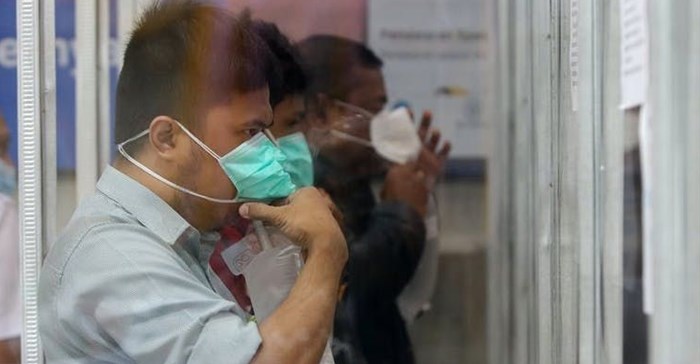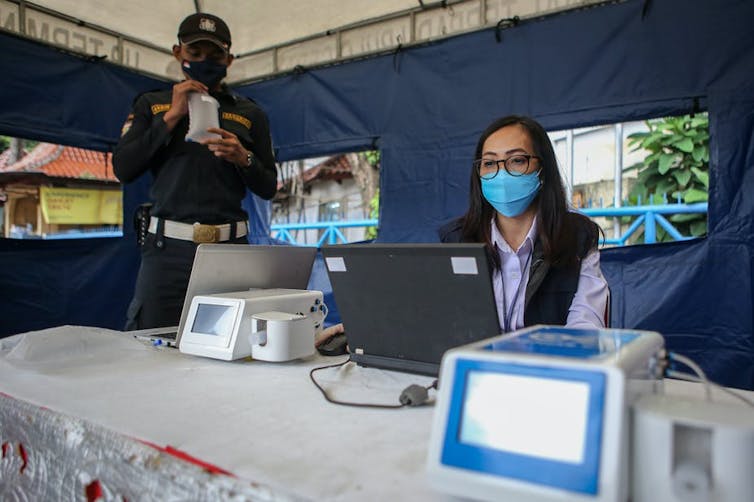Indonesian-made Covid-19 breathalyser sensitivity comparable to RT-PCR

Yet, testing capacity remains the foremost determinant of a country’s success in containing the virus. Lack of testing can paralyse any plan to curb the outbreak, as tracing and isolating Covid-19 suspects can only be done as much as the tests tell us.
We can see this in the high positivity rates of countries with lower testing capacity relative to their population size. While WHO has capped a maximum positivity rate at 5%, countries like Indonesia, Ukraine, Mexico, as well as several South American and African countries could hardly go below 15%. This is essentially the problem of low testing capacity.
These countries need testing innovation that can provide cheap, accurate and practical Covid-19 tests.
To answer this challenge, two of us (Dian and Kuwat) invented GeNose C19, a breath-based COVID-19 detection device. Our diagnostic trial on the device revealed 89-92% sensitivity for detecting positive cases, comparable to RT-PCR (89%) and antigen-based rapid test (89.9%).
Among its advantages, the tool that detects the infection through exhaled volatile organic compounds gives you the result in only three minutes. It costs only $ 0.7-1.7 or around 11-140 times cheaper than the other two tests.
Indonesian Covid-19 authorities has deployed the tool in train stations and bus terminals, in the hope that the device can speed up the passengers screening process.
A scientific manuscript containing detailed and sensitive information on the diagnostic trial and its working mechanism, including detailed artificial intelligence (AI) algorithms, is currently in preparation, pending patent issuance by the Indonesian Ministry of Law and Human Rights.
Electronic nose detecting COVID19 through expiratory gas
GeNose C19’s development is based on an AI-powered sensory system originally used for analysing food, beverage, and detecting tuberculosis.
GeNose C19 is an electronic nose mimicking the mechanism of the human nose for Covid-19 detection. The machine-learning-based AI system is trained to recognise the distinctive response pattern of an object. As such, GeNose’s artificial intelligence can be improved by increasing data input from the valid measurement results.

GeNose C19 went through three phases of development: response pattern discovery to determine its working mechanism, test standardisation, and diagnostic trial.
The research team carried out the first phase throughout April to August 2020, comparing the composition patterns of expiratory gases exhaled by patients warded in two hospitals. They compared over 316 COVID-19 positive breath samples to 299 breath samples with negative confirmation of Covid-19.
The research team discovered unique patterns in the composition of volatile organic compounds (VOCs) exhaled by Covid-19 patients from the first phase. VOC is composed of various gases exhaled when we breathe. Such gasses were formed through many biological mechanisms, including inflammation caused by viral or bacterial infections.
Our research found that the unique pattern identified in Covid-19 patients VOCs were not affected by existing co-morbid conditions, such as hypertension, asthma, and non-COVID pneumonia (lung inflammation caused by bacteria or other viruses).
VOC patterns obtained from infections of other viruses, such as paramyxovirus (that causes measles and acute respiratory infection), rhinovirus (cause of common cold), respiratory syncytial virus (most common cause of viral pneumonia) as well as bacteria are significantly different from that obtained from SARS-CoV-2, the virus that causes Covid-19.
The researchers embed the unique VOC pattern from exhaled Covid-19 patients’ breath into a machine learning module integrated into an AI-powered sensory system. In simple terms, this is akin to planting intelligence into a machine so that the device can complete specific tasks with high precision and speed.
Standardisation test and diagnostic trial
Subsequently, the research team spent October up to December 2020 to standardise the test and carry out diagnostic trials.
Test standardisation results establish the technical quality of the machine. Meanwhile, diagnostic trials results demonstrate the machine’s accuracy, sensitivity, and specificity compared to RT-PCR, the WHO-recommended gold diagnostic standard for Covid-19.
The sensitivity value refers to the ability of the tool (GeNose C19) to accurately detect cases that have been detected Covid-19 positive through PCR tests (also called “true positive” cases) as positive. In other words, the ability of GeNose C19 to suppress as low as possible the number of people it detected negative but were detected positive by the gold standard RT-PCR (also called “false negative”). Or the ability to detect “true positives” and avoid “false negatives.”
Meanwhile, specificity value refers to the ability of GeNose C19 to ensure that cases detected negative for COVID-19 by RT-PCR as the gold diagnostic standard (also known as “true negative” cases) are also detected negative by GeNose C19. In other words, the ability of GeNose C19 to suppress as low as possible the number of people who were detected positive with GeNose C19 but were detected negative by the gold standard RT-PCR (also called “false positives”). Or the ability to detect “true negatives” and avoid “false positives.”
The combination of the two, called the accuracy value, is the tool’s ability to provide correct diagnostic decisions, either positive or negative.
Indonesian Ministry of Health’s Agency for Monitoring of Health Facilities has issued a certification that GeNose fulfils standardisation requirement for a diagnostic tool, involving standards in the electricity system, pump response, mechanisms, module and other relevant aspects.
Subsequently, the diagnostic trial was carried out based on approvals on scientific merits and ethical standards. Scientific merit approval from the Ministry of Health after independent reviews involving relevant experts from the University of Indonesia, Bandung Institute of Technology, University of Airlangga, and the University of Hasanuddin established that the protocol had fulfilled standard for a diagnostic trial. Ethical approval was obtained after rigorous reviews by the research ethics committees of Universitas Gadjah Mada (where the research was based) and the Ministry of Health.
For transparency, the diagnostic trial protocol is registered and open for public access through an international database under registration number NCT04558372.
Initially, the diagnostic trial tested more than 2,500 breath samples from 1,476 Covid-19-suspected outpatients at seven hospitals. Breath sampling for GeNose C19 was conducted simultaneously with swab sampling for RT-PCR. Each was taken twice in two consecutive days. The research team also collected from each patient clinical, demographic and other relevant data such as sign and symptoms, race, contact history, food, drink, laboratory results and X-ray images (when indicated).
Following the completion of the initial recruitment and analyses in mid-December, the Ministry of Health’s team of independent reviewer requested additional research subjects recruited from the general public to determine the tool’s performance in an out-of-hospital setting. The research team added 523 additional subjects by randomly sampling office workers on several premises.
Finally, the diagnostic trial of 1,999 subjects revealed a sensitivity of 89% - 92%, specificity of 95-96% and an accuracy of 93-94%. The trial also provided a basis for the team to establish a standard operating procedure.
A sensitivity of 89-92% means that out of 100 people who were detected negative for Covid-19 with GeNose C19, there is a possibility that eight to eleven people would be detected positive by RT-PCR. This is also called a false negative.
A specificity of 95-96% means that out of 100 people detected positive for Covid-19 with GeNose C19, there may be four to five people detected negative by RT-PCR. This is also called a false positive.
The level of accuracy is obtained from a combination of sensitivity and specificity calculations.
The table shows that GeNose C19 provides a sensitivity value above 80%, as recommended by WHO, and comparable to RT-PCR as well as antigen-based rapid test.
Admittedly, the specificity value is slightly below 97%, as recommended by WHO. There have been debates among experts as to which one is more important, sensitivity or specificity.
Low sensitivity will potentially miss too many cases, which would lead to failure in isolating them from spreading the virus. Low specificity will unnecessarily overwhelm health and quarantine facilities from accommodating false-positive cases.
On December 24, Indonesia’s Health Ministry issued a distribution license for GeNose C19.

Advantages and disadvantages
We have to admit that none of the currently available diagnostic methods provides 100% accuracy, as the table above indicated.
A report showed that RT-PCR would detect the virus by day four or five after exposure. From GeNose C19 diagnostic trial, it was found that the tool was able to detect positive -and asymptomatic- cases two days after exposure.
Another advantage of GeNose C19 is that the method does not require delicate handling of virus specimen and complicated procedures, which take time as in RT-PCR. This enables GeNose to perform repeated testing in a general public setting at low cost and high speed, such as in train stations, airports, offices, schools and other public places.
The only limitation is that the tool becomes less accurate when the testing was interfered with several types of food, such as durian, bitter bean (petai), stinky bean (jengkol), onion, tea, coffee, and alcohol, if taken within 30 minutes before GeNose C19 testing.
To overcome this, GeNose C19 standard operating procedure requires fasting as least 30 minutes to one hour before breath sampling.
It is expected that GeNose C19 would help bump up Indonesia’s testing capacity. In the current situation of uncontrolled transmission, an impactful strategy would be one that can detect positive cases as many as possible to help trace and isolate patients and disrupt the chain of infection.
This article is republished from The Conversation under a Creative Commons license. Read the original article.![]()
Source: The Conversation Africa

The Conversation Africa is an independent source of news and views from the academic and research community. Its aim is to promote better understanding of current affairs and complex issues, and allow for a better quality of public discourse and conversation.
Go to: https://theconversation.com/africa























